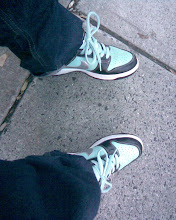I just stumbled onto this article by Vickie Chang from The Village Voice, dating back to late 2006, and, upon further inspection, was left highly impressed. It breaks down in fairly adequate detail (actually, to a highly satisfactory degree, given its mass-media limitations: I suspect that I would only consider a lengthy, if not outright doctoral, dissertation on the topic acceptable) the forms and root causes of Asian sexual and social objectification. The author, presumably a Chinese-American woman, seems to draw motivation and social rationale largely from personal experience, but does not ignore the ubiquitous nature of objectification: she touches, again to a reasonably contenting degree, on the complex interaction of other emasculative and exotificative threads, including those drawn tautly around Asian males and the gay Asian community.
Chang's article - again, presumably - for the reasons of (1) length constraints and (2) lack of personal experience, does have a limited (albeit wide-ranging) scope: she seems to rein in her criticisms to focus on a primarily White Other, not problematizing the behavior of any other ethnicities (self-problematic: I myself nearly wrote 'minorities', rather than 'ethnicities', before rebuking myself for thinking that Whites form the Majority; they do not, in a global sense). Of course, I understand to at least some degree (or assume I do): to discuss White stereotypes of Asians is largely an enterprise of digressing on the well-worn tropes of Imperialism/Colonialism that are well-established (if not outright cliche) in the world of Ethnic Studies, and to do so calls down on the author little scorn.
To discuss Black objectification of Asians (note: I saw recently - I don't recall where - Asians referred to as Yellow in the same way Black and White are used. Is this OK? Is there a memo I missed?) is to navigate entirely different waters, including the hypermasculization-/oversexualization-objectification (albeit largely predicated upon the action of Whites) of the Black male and female. Not to mention Latino/Native American/other ethnic populations whose interactions with Asians are more limited, and less likely to operate on easily-streamlined paths (for this reason, I strangely and broadly accept the limiting of discussion of Asian objectification to White and Black. Is this an oversight on my own part?). I have few qualms, however, about this: it is, given what the piece itself is likely intended to do (to wit: stimulate discussion, rather than serve as proxy for independently conducted discussion and thought), well within the author's perquisites to limit her discussion in such a fashion.
More potentially problematic is that the author overlooks the Asian lesbian community, instead focusing on the gay Asian population. Why is this more problematic? Well, I have two issues: one personal, one academic. By the former, I mean simply that, again, writings on the emasculating objectification of Asian males is unsurprising and fairly commonplace: another well-established theme of ethnic critiques, as widely known as the Sambo/Stepin Fetchit problem amongst Black ethnic commentators. I would have much rather learned more about the (at least relatively) unexplored topic of Asian lesbian fetishization. As for the latter, academic, critique, I feel that focusing on the emasculation of Asian gay males while simultaneously ignoring the (whatever) of Asian lesbians (a thought: should Lesbian and Gay be capitalized? Is there another memo?) may be treading close to expected - in a more sinister manner - and patronizing views.
Specifically, gay Asian men are often stereotyped (and desirable) as emasculated and ladylike "Bottoms", perhaps stemming from (or driving onwards) the popular ladyboy/hermaphroditic/transvestite fetishes of the Southeast Asian sex markets. Gay Asian women, on the other hand, are simply marginalized or often unspoken-of in broad discursive contexts (caveat: by "broad," I simply mean, that which I personally have read). Of course, this may have an innocuous and acceptable root: the author, interested in critiquing and broadening discussion on these topics may have constrained herself to stereotypes easily-accessible to a wide audience.
In any case, these minor qualms aside, I am quite satisfied with the article. Any coverage of Asian issues in mainstream or White-owned/-run publications without a disparaging sly wink or nod by an editor (or, even worse, a non-Asian author) is encouraging, especially in the White- and Hipster-voice skewed Village Voice. Even if it is two years old.
Sunday, August 31, 2008
The Village Voice - 11.7.2006 - Yellow Fever
Subscribe to:
Post Comments (Atom)


No comments:
Post a Comment